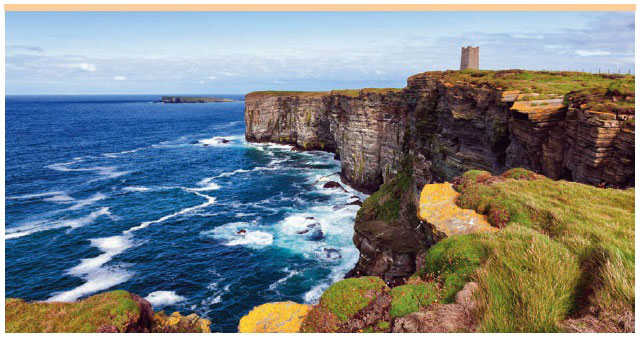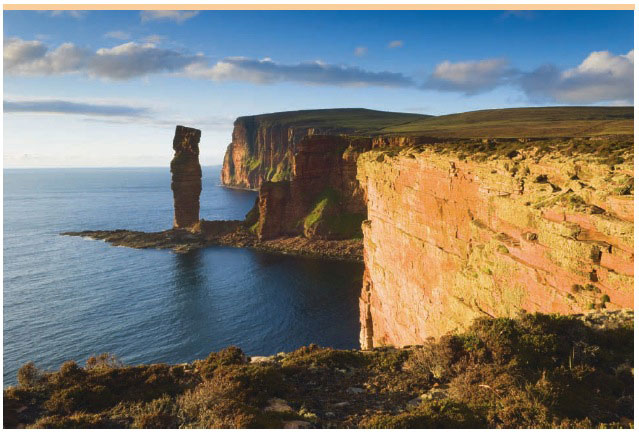Pilot Pentland Firth and Orkney Waters Marine Spatial Plan. The Plan Scheme 2012.
The Plan Scheme sets out step by step how the pilot plan will be prepared and outlines the opportunities for stakeholders to get involved. The Plan Scheme is updated and publicised at key stages in the process to inform stakeholders and the general public
SECTION 4 KEY STAGES IN THE PLANNING PROCESS AND OPPORTUNITIES FOR STAKEHOLDER PARTICIPATION
INTRODUCTION
The process for developing a pilot marine spatial plan for Pentland Firth and Orkney Waters started in 2009. The marine spatial plan will consist of three stages, one of which has been completed, one is ongoing and the third will be the plan itself. Marine Scotland has led on the first two stages, which has involved information gathering and setting out a high level framework as a baseline from which to work. A working group consisting of Marine Scotland, Orkney Island Council and Highland Council has now been created to continue the work and to develop the pilot plan itself. The work of the group will be carried out in conjunction with Marine Scotland's work on the statutory regional marine plan process i.e. setting the boundaries, considering governance and make-up of future regional marine planning partnerships as contained within the Marine (Scotland) Act 2010.
This section of the Plan Scheme sets out the main stages in the process so far and in the future.
It contains Participation Statements with details of planned and completed stakeholder engagement and consultation.
STAGE 1
PENTLAND FIRTH AND ORKNEY WATERS MARINE SPATIAL PLAN FRAMEWORK
The Pentland Firth and Orkney Waters Marine Spatial Plan Framework and Regional Locational Guidance for Marine Energy was completed and published by Marine Scotland in March 2011.
The documents are available on the Scottish Government website:
http://www.scotland.gov.uk/Topics/marine/marineenergy/wave/rlg/pentlandorkney
The main purposes of Stage 1 were:
- To set out a high level framework for taking forward the Plan in three stages;
- To identify the categories of information and knowledge that are required to underpin the plan including, but not limited to, biodiversity, fisheries, shipping, tourism and recreation;
- To summarise what is already known in each category; and
- To make recommendations on how the resulting information and data gaps should be addressed.
| Participation Statement - Stage 1 | |
|---|---|
| Date: March 2010 to July 2010 | |
| Method of Stakeholder Engagement / Consultation | Audience |
| Stage 1 draft document published on Marine Scotland website | All stakeholders and interested parties |
| Draft document emailed to stakeholders and feedback invited | All stakeholders |
| Public workshops for stakeholders held in Kirkwall, Scrabster and Edinburgh | All stakeholders |
STAGE 2
PENTLAND FIRTH AND ORKNEY WATERS RESEARCH STUDIES
Stage 2 is currently underway and consists of a suite of research studies undertaken, or commissioned, by Marine Scotland to address the information gaps identified at Stage 1.
The studies have been undertaken to inform and underpin the future development of the Plan. The studies are presented in the table below and will all be available from http://www.scotland.gov.uk/Topics/marine/marineenergy/wave/rlg/pentlandorkney once complete. Some of the research projects are relatively short term studies but others are longer term so the results from the studies will feed in as and when they are available.
| Pentland Firth and Orkney Waters Stage 2 Research Studies | Date due |
|---|---|
| Scot Map Inshore Fishing Study Pilot in Pentland Firth and Orkney Waters | Complete draft document published June 2012 |
| Commercial shipping and recreational boating study. | November 2012 |
Environmental studies:
|
November 2012 Draft completed End of 2013 Published |
| Hydrodynamic model of the physical oceanographic environment and energy resources | June 2014 |
| Value added study to examine value added to commercial fish landing as a result of processing and branding | End 2012 |
| Tourism and recreation study | Spring / Summer 2013 |
| Aquaculture study to review existing and future development | To be developed |
| Participation Statement - Stage 2 | |
|---|---|
| Date: 2011 - 2014 | |
| Method of Stakeholder Engagement / Consultation | Audience |
| Relevant stakeholders were engaged, as appropriate, for each study outlined in the table above. | Relevant stakeholders |
STAGE 3
PILOT PENTLAND FIRTH AND ORKNEY WATERS PILOT MARINE SPATIAL PLAN
3a) Plan Scheme
The Plan Scheme will be reviewed, updated and publicised at key stages in the plan making process to inform stakeholders of progress made. The Participation Statement below outlines how the Plan Scheme 2012 will be distributed and publicised.
| Participation Statement Stage 3a - The Plan Scheme | |
|---|---|
| Target Date: October - November 2012 | |
| Method of Stakeholder Communication/Engagement/ Consultation | Target Audience |
| Publish Plan Scheme 2012 - Raising awareness about the pilot marine spatial planning process. | All stakeholders - Published on Marine Scotland and Council websites and available at local libraries and Council Offices |
| Mail out via email or letter to stakeholders on the stakeholder database. | Plan Scheme sent to stakeholders |
| Local press advertisements. | General public / All local stakeholders |
| Press releases for local media e.g. newspaper and radio. | General public / All local stakeholders |
| Pilot Pentland Firth and Orkney Waters Marine Spatial Plan, Working Group -raising awareness of the process and identifying / consulting on the main issues and options. | General public / All local stakeholders |
New contacts will be added to the stakeholder database as new stakeholders are identified through Stage 3a (see Section 6).

Sea Cliffs at Marwick Head, Orkney
3b) Planning Issues and Options Consultation Paper
What is the Planning Issues and Options Consultation Paper?
The consultation paper is not a draft version of the pilot plan; it sets out the options and policy areas that the plan could address. It seeks views through stakeholder engagement and consultation and will enable stakeholders to inform the content of the pilot plan and consider alternative approaches to policies and proposals.
The paper will set out a preferred option and alternative options to addressing key issues and seeks views on these options through consultation with stakeholders. These options will be developed through workshops and public participation events.
| Participation Statement Stage 3b - Planning Issues and Options Consultation Paper | |
|---|---|
| Target Date: Winter 2012 - June 2013 | |
| Method of Stakeholder Engagement / Consultation | Target Audience |
| Preparing the Planning Issues and Options Consultation Paper: | |
| Preparation of Scoping Report and draft Environmental Report for Strategic Environmental Assessment. | Consultation authorities ( SNH*, SEPA*, Historic Scotland) and other relevant stakeholders |
| Public consultation workshops in Orkney and Caithness - Raising awareness of the process and identifying / consulting on the key planning issues and options. | All members of the public and interested stakeholders |
| Record responses to workshops, other public participation and feed back on the Plan Scheme. | All attendees and responders to consultation to identify issues and options |
| Focused discussion groups on key issues identified through consultation, as appropriate. | Interested Stakeholders |
| One to one stakeholder meetings, as appropriate | Interested Stakeholders |
| Local planning / Marine Scotland officers available to discuss the pilot plan. | Members of the publicand interested stakeholders |
| Briefing Note to OIC/ HC Councillors to invite comment | Councillors/public |
| Analyse responses to workshops, public participation events and feed back on Plan Scheme. | N/A |
| Consultation on the Planning Issues and Options Consultation Paper: | |
| Consultation Paper deposited for a minimum 6 week consultation period. | General public and all stakeholders |
| Notification sent to all stakeholders on the Plan database by email or letter inviting consultation responses. | Stakeholders that have registered interest |
| Local press advertisements. | General Public |
| Press releases for local media e.g. newspaper and radio. | General Public |
| Presentations / meetings with key agencies and interest groups. | Key agencies and interest groups |
*SNH - Scottish Natural Heritage, SEPA - Scottish Environmental Protection Agency
3c) Preparing the Draft Pilot Marine Spatial Plan
The Draft Pilot Marine Spatial Plan will set out policies and proposals for the management, development and use of the marine area. It will address the key planning issues identified in the Planning Issues and Options Consultation Paper and contain detailed policies and maps of plan. It will also contain a section on how to use the plan.
The policies:
It is anticipated that policies will be presented on the various types of development that are likely to take place in the marine area, for example, renewable energy development. The policies will contain some of the criteria for assessing consent applications for these various sectors. Other policies of relevance to all types of development are likely to focus on how the environment, natural resources and the interests and amenity of marine and coastal users will be assessed and safeguarded.
Maps of plan options:
The draft pilot plan will contain maps which could present key opportunities for development and the identified social, economic and environmental constraints or sensitivities. Constraints or sensitivities may include but not be limited to navigation routes, areas of importance for inshore fisheries, ferry routes and aquaculture sites, but do not necessarily mean that particular developments may not go ahead, only that additional mitigation may be required to address these issues.
| Participation Statement Stage 3c - Draft Pilot Marine Spatial Plan | |
|---|---|
| Target Date: June - November 2013 | |
| Method of Stakeholder Communication / Engagement / Consultation | Target Audience |
| Developing the Draft Pilot Plan: | |
| Record and analyse responses to the Planning Issues and Options Consultation Paper; prepare consultation report. | All attendees and responders to consultation to identify main issues and options |
| Focused stakeholder meetings to inform preparation of policies and proposals. | Interested Stakeholders |
| Consultation of the Draft Plan: | |
| Draft Pilot Plan, Environmental Report and the Habitats Regulation Appraisal ( HRA) Record deposited for a minimum of 6 week consultation. | General public and all stakeholders |
| Notification sent to all stakeholders on the stakeholder database by email or letter inviting consultation responses. | Stakeholders that have registered interest |
| Local press advertisements. | General Public |
| Press releases for local media e.g. newspaper and/or radio. | General Public |
| Presentations / meetings with key agencies and interest groups. | Key agencies and interest groups |
3d) Final Pilot Plan
The final pilot plan will be produced taking into consideration the comments received from the above consultation process.
3e) Pilot Plan Review
A review of the adopted pilot plan will be undertaken by the working group in consultation with the advisory group and stakeholders to consider the effectiveness of the policies and spatial guidance and to inform the development of Regional Marine Plans.

The Old Man of Hoy in evening light
Contact
There is a problem
Thanks for your feedback